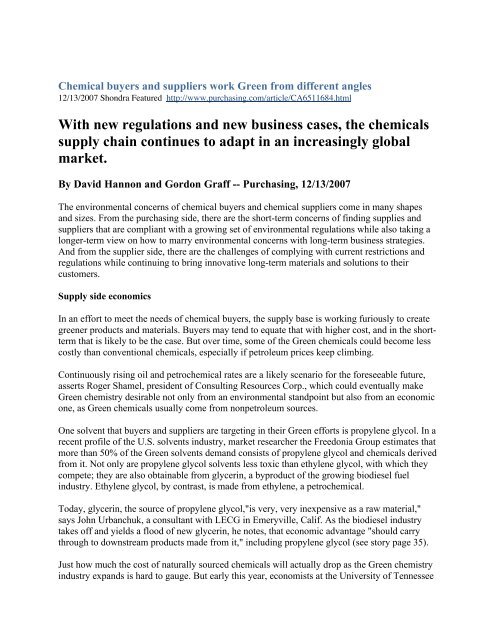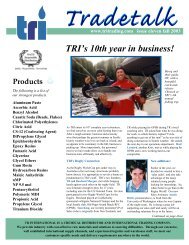Chemical buyers and suppliers work Green from different angles
Chemical buyers and suppliers work Green from different angles
Chemical buyers and suppliers work Green from different angles
Create successful ePaper yourself
Turn your PDF publications into a flip-book with our unique Google optimized e-Paper software.
<strong>Chemical</strong> <strong>buyers</strong> <strong>and</strong> <strong>suppliers</strong> <strong>work</strong> <strong>Green</strong> <strong>from</strong> <strong>different</strong> <strong>angles</strong><br />
12/13/2007 Shondra Featured http://www.purchasing.com/article/CA6511684.html<br />
With new regulations <strong>and</strong> new business cases, the chemicals<br />
supply chain continues to adapt in an increasingly global<br />
market.<br />
By David Hannon <strong>and</strong> Gordon Graff -- Purchasing, 12/13/2007<br />
The environmental concerns of chemical <strong>buyers</strong> <strong>and</strong> chemical <strong>suppliers</strong> come in many shapes<br />
<strong>and</strong> sizes. From the purchasing side, there are the short-term concerns of finding supplies <strong>and</strong><br />
<strong>suppliers</strong> that are compliant with a growing set of environmental regulations while also taking a<br />
longer-term view on how to marry environmental concerns with long-term business strategies.<br />
And <strong>from</strong> the supplier side, there are the challenges of complying with current restrictions <strong>and</strong><br />
regulations while continuing to bring innovative long-term materials <strong>and</strong> solutions to their<br />
customers.<br />
Supply side economics<br />
In an effort to meet the needs of chemical <strong>buyers</strong>, the supply base is <strong>work</strong>ing furiously to create<br />
greener products <strong>and</strong> materials. Buyers may tend to equate that with higher cost, <strong>and</strong> in the shortterm<br />
that is likely to be the case. But over time, some of the <strong>Green</strong> chemicals could become less<br />
costly than conventional chemicals, especially if petroleum prices keep climbing.<br />
Continuously rising oil <strong>and</strong> petrochemical rates are a likely scenario for the foreseeable future,<br />
asserts Roger Shamel, president of Consulting Resources Corp., which could eventually make<br />
<strong>Green</strong> chemistry desirable not only <strong>from</strong> an environmental st<strong>and</strong>point but also <strong>from</strong> an economic<br />
one, as <strong>Green</strong> chemicals usually come <strong>from</strong> nonpetroleum sources.<br />
One solvent that <strong>buyers</strong> <strong>and</strong> <strong>suppliers</strong> are targeting in their <strong>Green</strong> efforts is propylene glycol. In a<br />
recent profile of the U.S. solvents industry, market researcher the Freedonia Group estimates that<br />
more than 50% of the <strong>Green</strong> solvents dem<strong>and</strong> consists of propylene glycol <strong>and</strong> chemicals derived<br />
<strong>from</strong> it. Not only are propylene glycol solvents less toxic than ethylene glycol, with which they<br />
compete; they are also obtainable <strong>from</strong> glycerin, a byproduct of the growing biodiesel fuel<br />
industry. Ethylene glycol, by contrast, is made <strong>from</strong> ethylene, a petrochemical.<br />
Today, glycerin, the source of propylene glycol,"is very, very inexpensive as a raw material,"<br />
says John Urbanchuk, a consultant with LECG in Emeryville, Calif. As the biodiesel industry<br />
takes off <strong>and</strong> yields a flood of new glycerin, he notes, that economic advantage "should carry<br />
through to downstream products made <strong>from</strong> it," including propylene glycol (see story page 35).<br />
Just how much the cost of naturally sourced chemicals will actually drop as the <strong>Green</strong> chemistry<br />
industry exp<strong>and</strong>s is hard to gauge. But early this year, economists at the University of Tennessee
made some estimates for several chemicals. For example, the cost of obtaining succinic acid<br />
<strong>from</strong> cellulosic feedstocks was about 45¢/lb in 2005, <strong>and</strong> will probably fall to around 40¢/lb by<br />
2015, according to the study, led by Daniel de la Torre Ugarte <strong>and</strong> colleagues at Tennessee's<br />
Dept. of Agricultural Economics. Similarly, levulinic acid obtained <strong>from</strong> cellulose cost about<br />
59¢/lb to produce in 2005, the report found, <strong>and</strong> will likely drop to around 26¢/lb by 2015. And<br />
lactic acid <strong>from</strong> cellulose was obtainable in 2005 at a cost of about 45¢/lb, a figure that will<br />
decline to about 40¢/lb by 2015.<br />
Some <strong>Green</strong> chemicals are unlikely to become appreciably cheaper over the next decade. For<br />
example, it required about 46¢/lb to make 1,3-propanediol <strong>from</strong> corn starch in 2005, according to<br />
the Tennessee report, <strong>and</strong> this figure should remain essentially unchanged by 2015. Even corn<br />
starch-derived ethanol, a <strong>Green</strong> solvent as well as a fuel, won't budge in price, remaining at<br />
52¢/gal between 2005 <strong>and</strong> 2015.<br />
Proponents of <strong>Green</strong> chemistry are not discouraged <strong>and</strong> point out that even if prices of naturally<br />
sourced chemicals don't change—or even rise slightly—in the next few years, many of these<br />
products will still become cheaper than petroleum-based ones.<br />
Buy side<br />
Clearly, the regulation that has had the largest impact on the global chemicals industry has been<br />
the European Union's REACH regulation, which went into effect in June. It requires all<br />
manufacturers <strong>and</strong> importers in Europe to register <strong>and</strong> to disclose the chemical substances in<br />
their products before they can be sold in the EU.<br />
Shondra Garrigus, vice president of purchasing at Seattle-based chemicals distributor TRI, says<br />
in some ways the regulation has changed the way TRI does business.<br />
"For example, although we have always considered our relationships with <strong>suppliers</strong> of the utmost<br />
importance, we find the maintenance of lasting, open relationships with our <strong>suppliers</strong><br />
increasingly vital to the success of our business under REACH," she says. "When you have to<br />
identify the end-user <strong>and</strong> provide application information, there really isn't anything you can do<br />
to avoid being cut out of the business so now, more than ever, you need to thoroughly trust your<br />
<strong>suppliers</strong> as well as your customers."<br />
Most chemical <strong>buyers</strong> <strong>and</strong> <strong>suppliers</strong> say REACH should not be thought of as a European<br />
regulation, because in today's global economy, a marketplace the size of the European Union<br />
cannot be avoided. So for the time being, REACH has set the bar for environmental regulation in<br />
the chemicals industry, as RoHS did for the electronics industry.<br />
Garrigus believes "we are at least a few years away <strong>from</strong> enacting laws that regulate the U.S.<br />
chemical industry in the same way that REACH currently regulates the European chemical<br />
industry. However, any wise U.S. chemical company is going to start looking into these matters<br />
now in order to prepare themselves for that eventuality."<br />
But while a U.S. st<strong>and</strong>ard may be on the horizon, there are some immediate concerns to <strong>buyers</strong>.
"Certain materials I used to buy have been discontinued due to government regulations <strong>and</strong> as a<br />
result we've had to reformulate some of our blends," says Jeff Marcella, corporate senior buyer at<br />
Canadian General Tower in Cambridge, Ont. Specifically, he says in April of this year, the State<br />
of California's Office of Environmental Health Hazard Assessment elected to list di-isodecyl<br />
phthalate as a hazardous substance. And because his company does business in California,<br />
Marcella has had to find a substitute material.<br />
Case Study: Dow Corning sees a <strong>Green</strong> opportunity<br />
Ask Keith Huckle about the latest environmental regulations <strong>and</strong> initiatives impacting the<br />
chemicals industry <strong>and</strong> you don't hear words like "restriction" <strong>and</strong> "hindrance" much. Rather,<br />
when you ask the global chief product steward <strong>and</strong> risk manager at Midl<strong>and</strong>, Mich.-based Dow<br />
Corning about going <strong>Green</strong>, he uses terms like "business opportunity" <strong>and</strong> "eco br<strong>and</strong>ing." In<br />
fact, Huckle's title—or more specifically the order of his title—conveys Dow Corning's<br />
sustainability philosophy well: product steward <strong>and</strong> risk manager.<br />
Huckle's primary advice to companies looking for an approach to <strong>Green</strong> buying is twofold:<br />
approach it globally <strong>and</strong> apply it as a business strategy, rather than just h<strong>and</strong>ing it off to the<br />
compliance organization.<br />
"That's not to be disrespectful to those people in compliance because they play a critical role, but<br />
there are many opportunities in this <strong>from</strong> a business perspective <strong>and</strong> leveraging a crossfunctional<br />
team will let you both mitigate challenges <strong>and</strong> find the opportunities," he says.<br />
Dow Corning applied that cross-functional approach to its REACH Readiness Team, which was<br />
created <strong>from</strong> a charter <strong>from</strong> the CEO two years ago to help Dow Corning ensure its supply chain<br />
was in compliance with the European REACH regulation that went into effect in June. The team<br />
included representatives <strong>from</strong> the scientific/R&D organization, supply chain <strong>and</strong> procurement,<br />
compliance, legal, IT <strong>and</strong> the product line managers.<br />
While the team focused on REACH compliance, it was also on the lookout for business<br />
improvement opportunities that could come <strong>from</strong> going <strong>Green</strong>. For example, as part of its <strong>work</strong><br />
in these areas, the team focused on developing a systematic process of supply chain mapping.<br />
This revealed just how complex some of Dow Corning's supply chains are <strong>and</strong> provided a chance<br />
to simplify them while achieving REACH readiness.<br />
On the supplier management front, Dow Corning's increased communication <strong>and</strong> data sharing<br />
with <strong>suppliers</strong> to determine their level of REACH readiness also showed some surprises.<br />
"You might expect that <strong>suppliers</strong> based in Europe were better prepared than those outside Europe<br />
but that didn't necessarily follow," says Huckle. "You might assume that the larger companies<br />
are in better shape than the smaller ones, but that doesn't necessarily follow."<br />
At the same time, the team at Dow Corning uses trend analysis to determine the direction its<br />
customers will be going in areas of sustainability. Huckle says the company uses long-term, midterm<br />
<strong>and</strong> short-term forecasts because "not all regulations turn out the way you would expect."
But he insists that getting involved early helps influence their direction <strong>and</strong> underst<strong>and</strong> their<br />
parameters, so Dow Corning can align its supply chain in the most effective way.<br />
But beyond compliance to regulatory issues, Dow Corning is <strong>work</strong>ing with <strong>suppliers</strong> to<br />
incorporate more green thinking <strong>and</strong> product stewardship at the design phase of its products.<br />
"Benign by design" is a phrase often used to sum up the strategy, but there is clearly a costfocused<br />
business strategy at <strong>work</strong>.<br />
"We're looking to design out whatever might be an area of concern—toxic chemicals,<br />
unnecessary use of energy, or areas where we can cut costs out of the process," Huckle says of<br />
the company's "eco design" strategy. "And we make that process increasingly clear to our<br />
<strong>suppliers</strong> in the hope that they will know better how to serve us <strong>and</strong> what points are of particular<br />
importance to us."<br />
CLICK HERE to see Dow Corning’s REACH page<br />
Case Study: Texas Instruments paints its supply base <strong>Green</strong><br />
When you think of Texas Instruments, you may not think of chemicals. But the procurement<br />
organization at the Dallas-based electronics giant certainly thinks of chemicals—a lot. And much<br />
of that thinking involves how the chemicals TI uses will impact the environment.<br />
The semiconductor <strong>and</strong> electronic component manufacturing process requires the use of a variety<br />
of wet chemicals <strong>and</strong> alcohols, photoresists <strong>and</strong> hydrogen peroxide. TI currently has four<br />
procurement staffers dedicated to managing its sizeable chemicals spend. But as Bryan Vonfeldt,<br />
manager for chemicals <strong>and</strong> gas procurement for TI worldwide, is quick to point out, his team<br />
spends a lot of time collaborating with TI's Environmental Safety <strong>and</strong> Health organization to<br />
continuously paint its chemicals spend a darker shade of green.<br />
To start with, TI has a list of banned chemical substances that cannot—<strong>and</strong> will not—be sourced<br />
by TI's procurement team. Tim Yeakley, manger of process <strong>and</strong> product strategy in the<br />
worldwide Environmental Safety <strong>and</strong> Health (ESH) organization, explains there are several ways<br />
a substance will get on the list, the most common being regulatory compliance or customer<br />
requirements.<br />
If a substance is added to the banned list (or it looks like it may be soon), the sourcing team at TI<br />
will first consult the incumbent supplier to see if they can provide an adequate substitute.<br />
"Usually, the supplier knows this is coming before we do <strong>and</strong> is <strong>work</strong>ing on it <strong>and</strong> has an option<br />
for us," Yeakley says. And Vonfeldt points out that TI's continuous improvement processes in<br />
these areas focus on <strong>suppliers</strong> designing out any banned substances as early as possible.<br />
The ESH organization at TI has long maintained a Horizon Review process where potential<br />
regulations around the world are tracked <strong>and</strong> customer input is considered. The ESH team also<br />
solicits input <strong>from</strong> various internal organizations, including procurement, manufacturing, <strong>and</strong><br />
engineering.
"We <strong>work</strong> with industry groups to gather information on coming regulations <strong>and</strong> also internally<br />
have a net<strong>work</strong> of key personnel in TI who are responsible for reviewing the impact in their own<br />
business units," Yeakley says. "We will gather that information, feed that through for their<br />
evaluation <strong>and</strong> then decide if it needs a <strong>work</strong> team to promote a change in the rule or a change<br />
within TI."<br />
Yeakley says the company is <strong>work</strong>ing closely with its <strong>suppliers</strong> to ensure they are registered<br />
correctly in compliance with the REACH regulation in Europe. "If they don't we could have a<br />
supply-constraint issue," he says. But REACH is not just a European issue. TI considers it a<br />
global issue, as the company does not manufacture a <strong>different</strong> product for a <strong>different</strong> market.<br />
In addition to regulatory m<strong>and</strong>ates, the broader issue of environmental concerns is also a major<br />
consideration in chemicals supplier evaluation <strong>and</strong> selection. "We try to have a continuous<br />
improvement process with our <strong>suppliers</strong> to see if we can design out things that might be a<br />
concern later on," says Vonfeldt. Twice a year supplier reviews are conducted with chemical<br />
<strong>suppliers</strong> focusing on two major areas: technology <strong>and</strong> environmental concerns.<br />
TI's procurement team focuses much of its efforts on reducing waste as part of its <strong>Green</strong><br />
strategy—the part of the strategy that can impact the bottom line costs the most. Vonfeldt points<br />
out that his organization <strong>work</strong>s with other internal teams cross-functionally to find ways to buy<br />
less <strong>and</strong> extend the life of some chemicals or otherwise make its supply chain more sustainable.<br />
And no idea is swept aside.<br />
Four years ago, a very small (five people small) company came to TI with a product it claimed<br />
could save the company millions of dollars a year in natural gas costs. It was a catalyst that TI<br />
could add to its thermal oxidizers which would let the oxidizers function at a much lower<br />
temperature. Thermal oxidizers are used to burn off volatile organic compounds <strong>and</strong> have to be<br />
run at extremely high heat. The reduction in natural gas costs <strong>and</strong> wear on the oxidizers has<br />
proved extremely valuable.<br />
CLICK HERE to visit Texas Instruments’ Corporate Social Responsibility page
What it Means to Buyers:<br />
• There are two reasons to go <strong>Green</strong> in your chemicals spend: Regulatory compliance <strong>and</strong><br />
business strategy. Consider them both.<br />
• Environmental strategies in the chemicals supply chain require truly cross-functional teams, but<br />
purchasing can be the hub.<br />
• <strong>Green</strong> does not always mean more expensive. In fact there are examples of <strong>Green</strong> reducing<br />
costs.<br />
• Leverage relationships with industry groups, peers <strong>and</strong> <strong>suppliers</strong> to keep abreast of current <strong>and</strong><br />
potential chemicals regulations that could impact your sourcing strategies.<br />
<strong>Green</strong> Drivers<br />
Some of the issues that are driving companies like Dow Corning to make their supply chains<br />
more <strong>Green</strong>.<br />
• Energy reduction<br />
• Waste disposal<br />
• Climate change<br />
• Increasing cost of being "brown" instead of "<strong>Green</strong>"<br />
• Competitive <strong>different</strong>iation<br />
• Shareholder <strong>and</strong> consumer pressure<br />
• Regulatory compliance<br />
• Eco-br<strong>and</strong>ing<br />
Source: Dow Corning<br />
Who else is going <strong>Green</strong>?<br />
Appliance giant Whirlpool recently announced it was discontinuing the use of volatile organic<br />
compound (VOC) paints <strong>and</strong> eliminated emissions <strong>from</strong> its solvents. Whirlpool also reuses<br />
plastic foam that was previously sent to l<strong>and</strong>fills; it's now ground up <strong>and</strong> made into consumer<br />
products.<br />
Brazilian firm Braskem will build a new plant for polyethylene made <strong>from</strong> sugar cane ethanol,<br />
due to come online in 2009 at a capacity of 200,000 tons annually.<br />
E Ch i l d G R k E ill d l $1 6 billi l i T
Eastman <strong>Chemical</strong> <strong>and</strong> <strong>Green</strong> Rock Energy will develop a $1.6 billion plant in Texas to<br />
produce chemicals <strong>from</strong> petroleum coke instead of natural gas. Eastman will split the cost of<br />
the facility with <strong>Green</strong> Rock.





